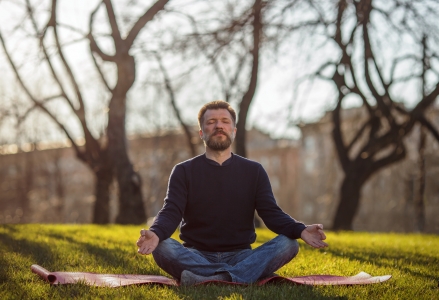To paraphrase the TalmudThe rabbinic compendium of lore and legend composed between 200 and 500 CE. Study of the Talmud is the focus of rabbinic scholarship. The Talmud has two versions, the main Babylonian version (Bavli) and the smaller Jerusalem version (Yerushalmi). It is written in Rabbinic Hebrew and Aramaic.: Who is forgiven? One who forgives others (Rosh HashanahThe Jewish New Year, also considered the Day of Judgment. The period of the High Holidays is a time of introspection and atonement. The holiday is celebrated with the sounding of the shofar, lengthy prayers in synagogue, the eating of apples and honey, and round challah for a sweet and whole year. Tashlikh, casting bread on the water to symbolize the washing away of sins, also takes place on Rosh Hashana. 17a). Many of us know from experience the enlivening catharsis and liberation that forgiveness brings. But we also know that it is not easily attained; it requires a radical shift in our inner life.
Some crucial guidance in this work is provided by R. MosesThe quintessential Jewish leader who spoke face to face with God, unlike any other prophet, and who freed the people from Egypt, led them through the desert for forty years, and received the Torah on Mt. Sinai. His Hebrew name is Moshe. ben JacobLit. heel Jacob is the third patriarch, son of Isaac and Rebecca, and father to the twelve tribes of Israel. More than any of the other patriarchs, Jacob wrestles with God and evolves from a deceitful, deal-making young man to a mature, faithful partner to God. His Hebrew name is Yaakov. Cordovero (1522–1570), known by the acronym Ramak, who was a leader of the Tzfat (Safed) kabbalists. His work, Tomer Devorah (The Palm Tree of Deborah) is a highly revered classic which combines KabbalahThe tradition of Jewish mystical interpretation of sacred texts. The foundational kabbalistic text is the Zohar. with Mussar (character improvement).
|
Tomer Devorah 1:14 Even if you cannot find any reason to forgive a person, then consider: There was once a time when this person had done no wrong. At that time … they were worthy. Bring to mind the good this person did as a child, bring to mind the love for a nursing babe, “weaned from milk and removed from the breasts” (Is. 28:9). In this way, you will appreciate that no person can be found who is unworthy of you wishing goodness for them, and praying for their wholeness, and having compassion for them. |
תומר דבורה א:יד שֶׁאֲפִלּוּ שֶׁלֹּא יִמְצָא טַעֲנָה מֵאֵלּוּ הַנִּזְכָּרוֹת יֹאמַר כְּבָר הָיוּ שָׁעָה קֹדֶם שֶׁלֹּא חָטְאוּ וַהֲרֵי אֹתָהּ שָׁעָה…הָיוּ כְּשֵׁרִים וְיִזְכֹּר לָהֶם הַטּוֹבָה שֶׁעָשׂוּ בְּקַטְנוּתָם וְיִזְכֹּר לָהֶם אַהֲבַת גְּמוּלֵי מֵחָלָב עַתִּיקֵי מִשָּׁדָיִם וּבָזֶה לֹא יִמָּצֵא אָדָם שֶׁאֵינוֹ רָאוּי לְהֵטִיבוֹ וּלְהִתְפַּלֵּל עַל שְׁלוֹמוֹ וּלְרַחֵם עָלָיו |
Meditation
-
Decide how long you want to practice for. If you’re new to this, try ten minutes. When you feel ready, gradually increase the practice time by five minutes at a time. Twenty minutes is a good sit for an intermediate practitioner, whereas more advanced meditators might sit for 45–60 minutes.
-
Set your intention to completely forgive a particular person. Do not start with the most difficult person you can imagine – work up to it! Our capacity for compassion and forgiveness respond to wise training, like physical muscles.
-
Sit quietly in a comfortable position, with the spine upright, and the body balanced between relaxation and alertness. Close your eyes.
-
Let out a few yawns or sighs to relax your body.
-
Now just sit, not trying to change or do anything, except observe whatever arises in your body and mind – thoughts, feelings, whatever comes.
-
With compassion, bring your chosen person to mind. What do they look like in each moment?
-
Throughout the practice, notice what thoughts and feelings arise for you, and keep returning to your intention, with determination and compassion: To fully forgive this person.
-
Imagine this person before they did whatever they did that hurt or offended you.
-
Imagine this person aging backward throughout their life until they are a tiny, helpless, beautiful, shining baby.
-
If you encounter serious difficulty, it may help to bring to mind another person, anyone who you find it easy to feel positively toward. Once you are visualizing them and feeling compassion toward them, try replacing them with your more challenging person, and maintaining the same positive feelings.
-
Notice any resistance that may arise, and simply keep returning to your original intention, with determination and compassion: To fully forgive this person.
-
When your practice time is completed, take note of how you feel. What is happening in your body?
-
You may find it helpful to write, draw, paint, speak, sing, dance or express what is happening inside you in this moment in some other way.













